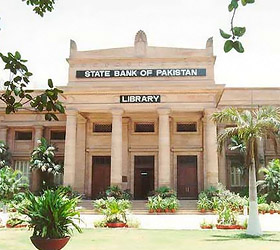 EDITORIAL (September 30 2010): A nation facing one of the biggest calamities in its history expected from its finest institution – State Bank of Pakistan – to do something different than just to opt for a pure vanilla-type response or a decision that lacks adornments or special features that is to keep the real interest positive – which in essence implies to have the SBP policy rate higher than inflation numbers.
EDITORIAL (September 30 2010): A nation facing one of the biggest calamities in its history expected from its finest institution – State Bank of Pakistan – to do something different than just to opt for a pure vanilla-type response or a decision that lacks adornments or special features that is to keep the real interest positive – which in essence implies to have the SBP policy rate higher than inflation numbers.
The monetary policy stance of raising the policy rate by 50 basis points to 13.5 percent as of September 30, 2010, a move expected by some but not all economists, is formed by the consideration that, according to Monetary Policy Decision’s accompanied narrative, inflation is substantial and the tightening stance is “full recognition that the difficulty to contain fiscal deficit has resulted in the private sector bearing the full brunt of such an adjustment”. The central bank’s stance, therefore, seeks to help pre-empt a build-up in inflationary pressures and anchor inflationary expectations. While one cannot disagree of that need to contain the fiscal deficit was there even prior to the floods, the policy response always has a means to an end.
Economists opposed to SBP’s present stance will come up with an argument that interest rates are raised if there is misallocation of resources or to stop over-borrowing from the banking system. Is the credit expansion, at present, higher than projected in the monetary plan? The answer is a big “No”. Is private sector borrowing too much? The answer again is a firm “No”. Is the money supply rise fuelling inflation? The answer is money supply is stagnant, but for the wrong reasons. Consider: Net foreign assets of the SBP have come down and the aggregate borrowing of the government from the banking system has risen by Rs 195 billion.
Borrowing from SBP, which is hot money (currency printing) as of mid-September is Rs 220 billion. However, due to rejection of two PIBs auction there is a net retirement of Rs 12.5 billion by the government from the commercial banks. SBP has expressed fear that fresh borrowing from commercial banks during the current financial year is very much on the cards as it sees “no commensurate increase in tax revenue.” This view of SBP strongly suggests that it has no confidence in the government’s commitment to fund its rising fiscal needs from revenue.
We do not blame the SBP for making this difficult or an unsavoury decision. After all, even before the flood the fiscal imbalances were quite acute. Government’s projection to raise revenues by 27 percent, in times of low growth coupled with postponing the reduction in the size of federal government by 18 months, failing to resolve either the circular debt or the ongoing power crisis, gross miscalculation in expecting the provinces to generate fiscal surplus of one percent, in the Federal Budget and to top it all giving a 50 percent rise in wages to civil servants (which were not part of the original budget estimates) – made it quite clear to all that Islamabad had got it wrong.
Facing an even more precarious economic situation, after the recent floods, SBP appears to have taken a more forward-looking approach by resolving not to allow the real borrowing rates from falling below the Consumer Price Index as lower policy rates can complicate the inflation outlook and impair inflationary expectations.
No doubt, the SBP policy rate hike will greatly disappoint the business community. But what SBP is clearly signalling to the nation is to pressurise the government to curtail its borrowing and retire its debt by selling assets it holds in the form of public sector entities notoriously known as white elephant. And, at the same time get out of commodity sector to stop the haemorrhage of the federal budget. The SBP Act in the present form does not allow it to block fresh government borrowing from the central bank. It is now up to the Parliament to enforce, strictly and urgently, the Fiscal Responsibility and Debt Limitation Act (2005). Failing which SBP will keep on raising interest rates as well as depreciating the rupee to keep the forex reserves above a minimum threshold. Reversal in this policy will only come when the government behaves in a more responsible manner.
SBP’s monetary statement also clearly accepts the fact that the brunt of high interest rates is being borne by the private sector – regarded as the engine for growth. The business community, instead of assaulting the SBP, needs to pressurize the government to cut back on its borrowings in aggregate terms from the banking system. It is high time that both federal and provincial governments pay heed or else they will be booted out at the next polls – Brecorder










